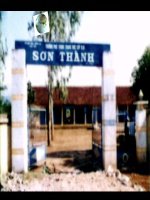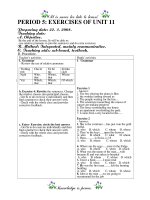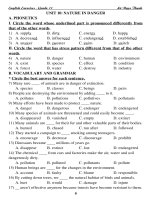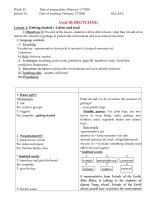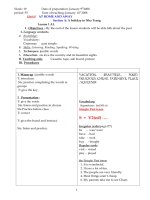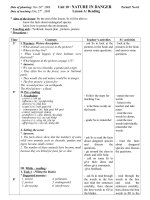e8 unit 10 xem se ro
Bạn đang xem bản rút gọn của tài liệu. Xem và tải ngay bản đầy đủ của tài liệu tại đây (177.87 KB, 12 trang )
Week: 22 Date of preparation: February 11
th
2008
period: 61 Date of teaching: February 13
st
2008 8A1, 8A2,
Unit 10: RECYCLING
Lesson 1: Getting started + Listen and read
I. Objectives: By the end of the lesson, students will be able to know what they should do to
reduce the amount of garbage to protect the environment and save natural resources
1. Language contents.
a) Knowledge:
Vocabulary: representative (n) recycle (v) protect (v) natural resources (n)
Grammar:
b) Skills: listening, reading.
2. Techniques: matching, pairs work, prediction, gaps fill. Jumbled words, True/False
prediction, Brainstorm…
3. Education: sts know to protect the environment and save natural resources
II. Teaching aids: cassette, sub board
III. Procedures:
1/ Warm up(5’)
Brainstorm
T: ask:
Sts: work in groups.
T: suggest.
Sts: complete : getting started
2. Presentation(10’)
T: present new words
Sts: listen and repeat
Sts: Practice before class
* Jumbled words
T: introduce and give the board
Sts: complete
T: give the key
T: Set the scene:
What should we do to reduce the amount of
garbage?
- reuse plastic bags
Possible answer: Use cloth bags, use tree
leaves to wrap things, make garbage into
fertilizer, make vegetable matter into animal
food…
New words
-representative (n)
-protect (v) = keep someone/ s.th safe
-natural resource (n) (coal , oil/gold/mineral)
-recycle (v) = to make something already used
able to be used again)
* Jumbled words
1 2 3
4 5 6
A representative from Friends of the Earth,
Miss Blake, is talking to the students of Quang
Trung school. Friends of the Earth shows
people how to protect the environment and
tconatc
presentativea ceresoru
ralnuta ropttce
cyrecel
Sts: guess and check T or F.
Sts: listen to the tape
3. Practice (20’)
Sts: listen to the tape while reading the
dialogue.
Sts: practice the dialogue ( pairs)
Sts: read the dialogue, check T / F again
Sts: correct the False statements
T: give the key
Sts: answer the questions
Sts: work in pairs, ask and answer
Sts: correct friends
T: correct
4. Consolidation (5’)
Discussion
T: Write the topic on the board
“How to protect our environment?”
Sts: express their opinions/ideas on the board
T: correct and has Ss copy
5. Homework (5’)
- Do exercises in workbook
-Learn by heart new words
-Prepare next lesson : Lesson 2 Speak
save natural resources
True/False predictions / Marks
1/ Friends of the Earth is an organization to
help people make friends with each other
2/ Miss Blake asks the students to remember 3
things: reduce, reuse, recycle.
3/ Reduce means buying the products which
are overpackaged.
4/ We can not reuse things like envelopes,
glass, plastic bottles, old plastic bags.
5/ Miss. Blake says that we should use cloth
bags and shouldn’t use plastic bags at all.
6/ Recycling means not just throwing things
away but trying and finding another use for
them.
Answer key
2, 5, 6: True
1. False … an organization to help people
protect the environment and save natural
resources
3. False Reduce means not buying…
4. False we can reuse things …
* Comprehension questions
a/ Reduce means not buying product which are
overpackaged
b/ We can reuse things like envelopes, glass,
plastic bottles and old plastic bags
c/ Recycle means not just throwing things
away. Try and find another use for them.
d/ We can look for information on recycle
things by having a contact with an
organization like Friends of the Earth, going to
the local library, or asking your family and
friends or scientific society.
e/ (Possible answer) Miss Blake tells Lan that
we shouldn’t use plastic bags at all because
plastic bags are difficult to be destroyed, so the
amount of garbage increases.
Week: 22 Date of preparation: February 11
th
2008
period: 62 Date of teaching: February 15
st
2008 8A1, 8A2,
Unit 10: RECYCLING
Lesson 2: Speak and Listen
I. Objectives: By the end of the lesson, students will be able to know some kinds of garbages
and know how to make compost.
1. Language contents.
a) Knowledge:
Vocabulary: compost, leather, fabric, pick, shovel, grain, heap, moisture, condensation (n)
Grammar:
b) Skills: speaking and listening,
2. Techniques: prediction, gaps fill, Brainstorm, matching…
3. Education: Sts know to protect the environment and save natural resources
II. Teaching aids: cassette, sub board
III. Procedures:
1. Warm up (5’)
T: show the picture and ask.
Sts: look and tell the names. (group)
T: remark and give more information.
2.1 Pre-speaking (5 ’)
T: introduce the words
Sts: listen and repeat, then practice before
class.
T: correct.
Sts: read.
T: ask sts to group the words to the materials.
What things are there in the picture?
Possible answer
Used paper, old newspapers, books,
cardboard, boxes, bottles, glasses, jars, plastic
bags, food cans, drinking tins, vegetable
matter, clothes, shoes, schoolbags,…
New words
-Compost (n) it is a kind of fertilizer made
from spoiled food, leaves, vegetable matter …
-fabric (n) (realia: clothes)
(What are these clothes made of?)
-leather (n) (our shoes, sandals are often made
of …?
Answer key
Group Items
Paper used paper (old newspaper,
books, cardboard boxes)
Glass bottles, glasses, jars
3. While-speaking (20’)
Plastic plastic bags, plastic bottles
Metal food cans, drinking tins
Fabric Clothes (cloth bags,
material)
Leather Shoes, sandals, school bags
Vegetable
matter
Fruit peels, (vegetables,
rotten fruit
Which group (do
clothes) belong to?
What can we do
with (those clothes)?
Are/Is (fruit vegetable
matter)?
What will we do with
(it)
Put them in
(fabric)
We can recycle
them and make
them into paper
or shopping bags
That’s right
We make (it into
compost and
fertilize our
field )
4. Post-speaking (5’)
Put these words into the correct groups
Aluminum cans –apple pie- butter-cakes-car
tires-old clothes-dictionary-waste paper-
glassware-horror story-jam-magazines-
newspapers-plastic toys-picture books-pork-
vegetable matter-textbook-novels
> Things to eat : ......................................
>Things to read :.........................................
>Things to recycle : ..................................
5. Homework(5’)
-Do exercise in the workbook.
-Practice the dial with your partners replacing
the information.
-Prepare : lesson 3 Listen
Warm up (5’)
.What can we do with “vegetable matter” ?
.Do you know how to make compost ?
.Should you water the compost ?
Pre-listening (10’)
tissue (n)
pick (n)
shovel (n)
shade (n)
grain(n)
compost heap(n)
moisture (n)
condensation (n)
pile(n)
*** Rub out and remember
While- listening (20’)
Answer key
a. A b. B c. A d. B
4. Post- listening (5’)
True or false statements
a/ The expert explains how to start a compost heap
b/We can use meat or grain products to make compost
c/ We should find a place in our garden that gets a few
hours of sunlight each day
d/ We shouldn’t use picks to turn the compost
e/ If the weather is very wet , we should cover the heap with
a sheet of strong plastic
Homework (5’)
-Do exercise in the workbook.
-Learn new words
-Prepare: lesson 3 Read.
